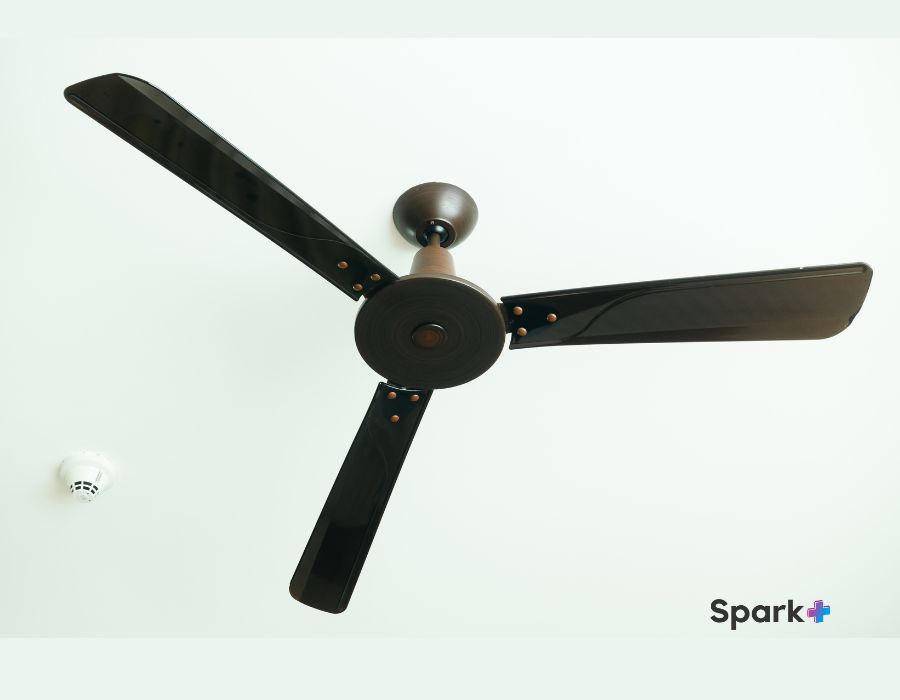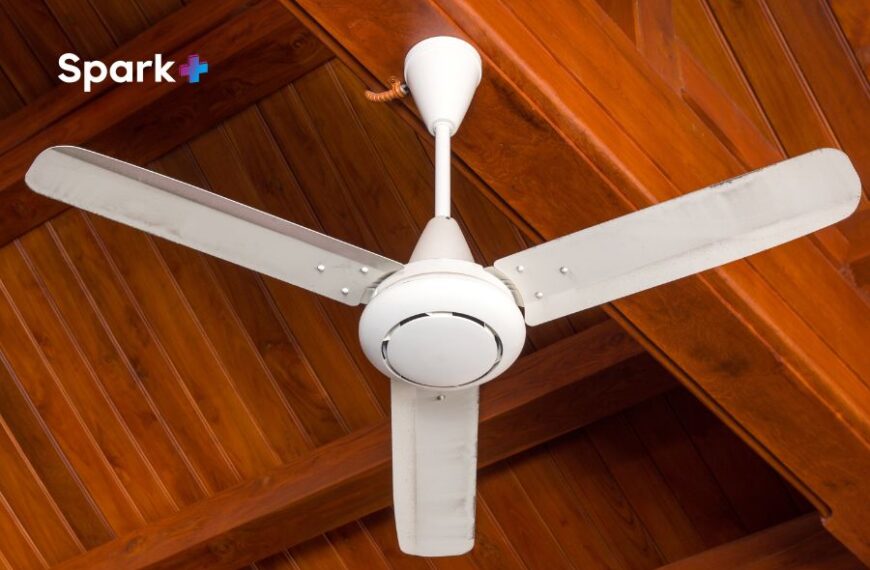Choosing the Perfect Ceiling Fan for Your Space
When the summer heat is on, ceiling fans are an excellent way to keep your house cool and easy. They also provide a fashionable design element and another source of light to your room. Choosing the ideal ceiling fan for your room can seem like a difficult chore, though, with so many various types and designs of ceiling fans available.
Before making a purchase, it’s important to take a few considerations into account. The appropriate ceiling fan can significantly improve the comfort and style of your home. When selecting the ideal ceiling fan for your space, consider the following elements: room size, ceiling height, style, and energy efficiency.
While choosing a ceiling fan for your house, this guide will assist you in understanding all of the options available and helping you make an informed decision. We’ll talk about the many different kinds of ceiling fans, how to pick the correct size for your room, and the various possible styles and designs. We will also review additional things to considerover additional things to think about before buying, such as energy efficiency.
By the end of this article, you will have the information and confidence to select the ideal ceiling fan for your room, ensuring that you stay a cool and cozy while to select the ideal ceiling fan for your room, ensuring that you stay cool and cozy while also giving your house a dash of elegance.
The Benefits of Ceiling Fans
Many homeowners prefer ceiling fans because of their numerous advantages. Their energy efficiency is one of the main advantages. Ceiling fans are a great choice for people trying to reduce their energy costs because they use a lot less electricity than air conditioners. Additionally, they offer a more natural cooling effect by generating a breeze in the space, which gives the impression that it is colder without actually lowering the temperature.
As they don’t release any potentially dangerous gases or chemicals into the air, ceiling fans are also an ecologically friendly solution form. They also don’t require a lot of maintenance, merely the occasional maintenance and cleaning to keep them in excellent working condition.
Types of Ceiling Fans
Ceiling fans come in a wide range of designs and styles, making it easy to find one that matches your decor and personal taste. The most common types of ceiling fans include:
- Standard Ceiling Fans – These are the most common fans, which are available in a variety of sizes and shapes. They are appropriate for rooms with a minimum height of the ceiling of at least 8 feet and normally include three to five blades.
- Low-Profile Ceiling Fans – These fans, commonly referred to as hugging fans, are made for spaces with low ceilings.They are mounted flush to the ceiling and have a shorter downrod than standard ceiling fans.
- Dual-Motor Ceiling Fans – You can control the speed and direction of each motor separately with these fans because they feature two independent motors. They work most effectively in bigger areas or outside.
- Energy Star Ceiling Fans – Due to their very energy-efficient design, these fans can reduce your energy costs. In most cases, they use a DC motor, which uses less energy and makes less noise than conventional AC motors.
Installing a Ceiling Fan Step-by-step guide
A great way for improving the comfort and style of your house is by installing a ceiling fan. It’s crucial to make sure that the installation procedure is carried out properly whether you’re installing a new fan or replacing an old one. Here is a step-by-step instruction manual to help you effectively and safely install your ceiling fan.
Step 1: Choose the Right Location
Choosing the ideal location is the first step in ceiling fan installation. It’s essential to make sure the fan is placed in a location where it will efficiently cool the space. To prevent any accidents, ensure sure there is enough space around the fan.
Step 2: Turn off the Power
Make sure to switch off the power to the location where you will be placing the fan before beginning the installation process. By turning off the circuit breaker or removing the fuse from the fuse box, you can accomplish this.
Step 3: Assemble the Fan
After that, put the fan together in accordance with the manufacturer’s instructions. Because every fan is distinct and can require a different building process, be sure to carefully follow the instructions.
Step 4: Install the Mounting Bracket
Once the fan is put together, you may start mounting the bracket. The part that fastens the fan to the ceiling is the mounting bracket. Use the right screws for your type of ceiling and secure the installation.
Step 5: Connect the Wires
Next, connect the wires from the fan to the wires in the ceiling. This step requires careful attention to detail, so it’s essential to follow the manufacturer’s instructions carefully. You may need to hire an electrician if you’re not comfortable with electrical work.
Step 6: Install the Fan
The fan can be fastened to the mounting bracket after the cabling has been connected. Use the proper screws and hardware, and be sure to carefully follow the manufacturer’s instructions.
Step 7: Attach the Blades and Light Fixture
Finally, attach the blades and light fixture to the fan. Make sure to follow the manufacturer’s instructions carefully and use the appropriate hardware.
Step 8: Turn on the Power and Test the Fan
After completing the installation, switch on the power and check the fan to make sure it is operating properly. You can use your new ceiling fan if everything is operating properly.
How To Maintaining Your Ceiling Fan
Tips for cleaning and caring for your ceiling fan, as well as the need of routine maintenance
In the summer, ceiling fans are a terrific method to move the air around your house and keep it cool. To keep them operating smoothly and effectively, they do, however, need routine maintenance, just like any other equipment. Your fan will last longer with routine maintenance since it will continue to operate properly. Here are some pointers for taking care of and maintaining your ceiling fan.
Importance of Regular Maintenance
For a number of reasons, regular ceiling fan maintenance is crucial. First of all, frequent maintenance will guarantee that your fan is operating well, saving you money on energy costs over time. Second, routine upkeep will avoid any potential problems with the fan’s performance, such noisy operation or wobbly blades. The lifespan of your fan will be extended by routine maintenance, guaranteeing that it will last for many years.
Tips for Cleaning and Caring for Your Ceiling Fan
Cleaning your ceiling fan is an essential part of maintenance. Here are some tips for cleaning and caring for your fan:
- Before you clean your fan, turn the power off.
- To clean the blades and motor housing, use a soft-bristled brush or microfiber cloth.
- The motor housing and blades can be cleaned with water and a light detergent. Avoid using chemicals or harsh cleaners since they can harm the fan’s coating.
- Avoid getting water on the wiring or the motor.
- To avoid water damage, clean the fan blades and motor housing with a dry cloth.
- Every year, add a few drops of oil to the fan motor and bearings to ensure smooth functioning.
- To prevent swaying or a noisy operation, tighten any loose screws or nuts on the fan.
- Utilising a balancing kit, check the equilibrium of the fan. The fan may wobble or operate loudly if it is out of balance.
- Finally, to save energy and lessen heat buildup, think about switching the light bulbs in the fan with LED ones.
Conclusion
It’s essential to maintain your ceiling fan to make sure it functions well, lasts a long time, and helps you save money on energy costs. Simple maintenance procedures like routine cleaning, lubricating, and checking for loose screws may keep your fan operating effectively. In addition, LED bulbs use less energy and produce less heat than conventional lamps. By following these easy maintenance suggestions, you can make sure that your ceiling fan continues to be a dependable and cosy source of air circulation for many years to come.














